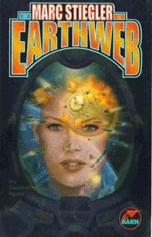Tales Of The Self-Indulgent: Earthweb by Marc Stiegler
permalink categories: books · tales of the self-indulgent originally posted: 2007-01-20 12:14:41Make no mistake: I'm a big fan of Marc Stiegler's writing. He's a real-life technologist, having worked as a manager at Autodesk (on Project Xanadu no less); these days he works as a researcher at HP, on subjects like capability-based computer security. As such, the technology featured in his stories has a decidedly realistic feel. He's published two sci-fic novels and a short story collection, and I own and enjoy all three.
 Stiegler's
first book, 1988's David's Sling, is one of my favorite
sci-fic novels. Some of the story is a bit dated—a warlike aggressive
USSR is the overarching protagonist—but it's a fun, compelling tale.
And there are some marvelous ideas in it, like the Zetetic Institute and
its teachings, and the effects of information-age technology on
industrial-age warfare. The book was also marvelously prophetic about the
coming age of ubiquitous computer networking and some of its effects on
society. It even predicted hypertext—which is especially surprising
as it predates Mr. Stiegler's experiences with Project Xanadu by
several years.
Stiegler's
first book, 1988's David's Sling, is one of my favorite
sci-fic novels. Some of the story is a bit dated—a warlike aggressive
USSR is the overarching protagonist—but it's a fun, compelling tale.
And there are some marvelous ideas in it, like the Zetetic Institute and
its teachings, and the effects of information-age technology on
industrial-age warfare. The book was also marvelously prophetic about the
coming age of ubiquitous computer networking and some of its effects on
society. It even predicted hypertext—which is especially surprising
as it predates Mr. Stiegler's experiences with Project Xanadu by
several years.
A note on its cover: Like many sci-fic books of the time, it suffers from irrelevant-cover-art-itis. The massive spaceship blasting off for parts unknown its cover depicts has essentially nothing to do with the story found inside; apart from some unmanned flying vehicles and satellites, all the action is decidedly earth-bound. One gets the sense that publishers commision book cover art by the pound; either that or recycle commissioned artwork from books that never wound up making it to market. Either way, it seems like the publisher picked an existing painting out of a bin, said "good enough, use that", and moved on.
 So on
to 1999's Earthweb, which happily features relevant cover artwork.
In this future, an alien civilization has seemingly declared war on
Earth, and periodically sends a giant heavily-armed automated space
station (a "Shiva") to wipe out humanity. After losing several
large cities, a suicide squad took out the station. Now the Shivas
show up every five years, and humanity must assemble suicide squads
("Angels") to infiltrate them and blow them up from inside. But
each one gets successively harder and harder to crack...
So on
to 1999's Earthweb, which happily features relevant cover artwork.
In this future, an alien civilization has seemingly declared war on
Earth, and periodically sends a giant heavily-armed automated space
station (a "Shiva") to wipe out humanity. After losing several
large cities, a suicide squad took out the station. Now the Shivas
show up every five years, and humanity must assemble suicide squads
("Angels") to infiltrate them and blow them up from inside. But
each one gets successively harder and harder to crack...
Examining Earthweb as a work of fiction, the Shivan menace is really just a plot device to get events moving. The bulk of the story is the selection and training of the team, and the global trading and betting network that has risen up. Again, it's a great read, and I highly recommend it.
By chapter four, we've met a young lady, and been introduced to her well-connected, rich, and slightly mysterious father. And then we read this:
As a child, her favorite painting had been a picture of a flying battleship, dashing fiercely across a field of fire where every color of the rainbow danced in a frenzy of light. The painting was the original cover for an early SF book about the coming age of global networking. She had read the book once, as a child, and had received a small shock that prepared her well for a future of Web literature. The book had not contained a single word about flying battleships. She liked the painting nonetheless.Just goes to show you that everyone gets the urge to be a little self-indulgent now and then.

 RSS
RSS